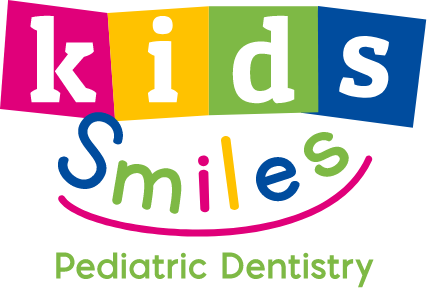Flossing is a simple habit with a big impact—and it’s not just for grown-ups. If you’re wondering, “When should my child start flossing?”, you’re not alone. Parenthood doesn’t come with a handbook!
Knowing what age to start flossing is one of the most common questions we get from parents at Kids Smiles Pediatric Dentistry, and it’s a great one to ask. Let’s break it all down:
When should my child start flossing?
Flossing removes food and plaque between teeth—where toothbrushes can’t reach—and helps prevent cavities, especially in those tight spaces. Flossing your child’s teeth is essential for removing plaque and preventing cavities in areas a toothbrush can’t reach, and helping your kiddo establish positive oral hygiene habits early.
Parents should begin to floss their child’s teeth as soon as their teeth begin to touch, which usually occurs around ages 2 to 3. When the teeth begin to close the gaps and they can no longer reach between each tooth with a toothbrush, it’s necessary to start cleaning between them.
Your Introduction to Kids’ Oral Health
Oral health is an extremely important part of your child’s overall health and happiness. Caring for your child’s baby teeth from an early age sets the foundation for a lifetime of healthy smiles. Establishing a daily routine that includes both brushing and flossing helps prevent tooth decay and gum disease—two of the most common dental problems in children.
The American Dental Association recommends that children start flossing as soon as two teeth touch, which often happens around age 2 or 3. At this stage, food particles and plaque can get trapped between teeth, where a toothbrush simply can’t reach. By making flossing a regular part of your child’s daily routine, you’re helping them develop a healthy habit that will protect their teeth and gums as they grow.
Introducing flossing at an early age not only keeps your child’s mouth clean, but also teaches them the importance of taking care of their teeth. With your guidance, your child will learn that brushing and flossing go hand in hand for strong, healthy teeth and gums.
Why Flossing Baby Teeth Matters
Some parents think baby teeth don’t need as much care since they’ll fall out anyway—but baby teeth play a crucial role in a child’s development. Flossing children’s teeth and toddler’s teeth is essential to prevent oral health issues and establish good habits early on. They help with:
- Chewing and proper nutrition
- Speech development
- Holding space for adult teeth
Cavities in baby teeth can cause pain, infections, and even damage the permanent teeth growing underneath. Not flossing a child’s teeth can also lead to gingivitis, which is an early stage of gum disease marked by redness and swelling. That’s why starting flossing early is one of the best things you can do to protect your child’s oral health.
For kids with braces or space-maintainers, flossing becomes even more important. Trapped food around appliances can lead to cavities and gum irritation if not cleaned out thoroughly.
If you have questions about the best way to floss your child’s teeth or want tips for your child’s oral hygiene routine, reach out to your Kids Smiles children’s dentist for professional advice and guidance.
How Often Should You Floss?
Whether you have a toddler or a grown-up, once a day is the golden rule.
Ideally, floss your child’s teeth before bedtime, when food and plaque have built up from the day. Once it becomes part of the nightly routine—just like brushing—it’s easier to stick with long-term.
Still building the habit? Start slow. Even flossing a few nights a week is better than none. Consistency is key.
If you notice some bleeding or your child’s gums bleed when starting a flossing routine, this is normal and usually improves with regular cleaning and flossing. Be gentle to avoid injuring your child’s gums, as healthy gums are important for overall oral hygiene.
Removing Plaque: The Science Behind Flossing
Flossing is more than just a healthy habit—it’s a powerful tool for protecting your child’s teeth from cavities and gum disease. Plaque is a sticky film of bacteria that forms on teeth every day. If it’s not removed, plaque can lead to tooth decay, gum disease, and even bad breath.
Traditional dental floss is designed to fit closely between teeth and along the gum line, where it can remove plaque and food particles that a toothbrush leaves behind. To floss properly, gently curve the floss around each tooth in a “C” shape and slide it up and down, making sure to clean beneath the gum line without snapping or forcing the floss.
There are also other tools, like floss picks and water flossers, that can help remove plaque—especially for little hands or hard-to-reach areas. The key is to make flossing a daily routine, so bacteria and food don’t have a chance to cause problems.
By helping your child remove plaque every day, you’re not only preventing cavities and gum irritation, but also supporting fresher breath and healthier gums. Teaching your child to floss early gives them the skills they need to keep their teeth clean and their smile bright for years to come.
Flossing Tips for Parents
Flossing a toddler’s tiny teeth might feel like wrestling a wiggly octopus—but it is possible with a little practice and a lot of patience. Learning how to properly floss your child’s teeth is essential for preventing plaque buildup and promoting good oral health.
Here are a few tips:
- Make flossing fun by turning it into a game or singing a favorite song together to keep your child engaged.
- Use about 18 inches of dental floss. Wrap most of the floss around the middle finger of one hand and the rest around the middle finger of the other hand. Use your index fingers to guide the floss gently between your child’s teeth, controlling the movement with your fingers to avoid hurting their gums.
- After cleaning between one tooth, move the floss to a clean section and gently slide it between the next tooth, repeating the process until all teeth are cleaned.
- Be gentle and patient, using your fingers to control the floss and ensure you reach all areas without causing discomfort.
1. Use the Right Tools
Look for children’s dental floss or flossers designed for toddlers. These often come with fun colors, kid-sized handles, or even favorite cartoon characters to make flossing feel less like a chore. Some flosses also come in fun flavors, making the experience more enjoyable and encouraging kids to floss regularly.
When choosing between regular floss and a floss pick, consider your child’s needs. Regular floss is effective at removing plaque and cleaning between teeth, while a floss pick offers convenience and is easier for little hands to use. Parents who prefer classic methods can opt for traditional floss, which is available in various types such as waxed, flavored, or even silk flosses to suit children’s preferences.
Flossers designed for kids often use a soft floss thread, and some may be coated with fluoride for added protection against cavities.
Floss for toddlers should be soft, gentle on their gums, and easy for you to maneuver.
2. Make It a Game
Sing a short song, use a sticker chart, or let your child “floss” a stuffed animal’s teeth first. Many flossing tools and games are designed to fit children’s smaller mouths, making flossing more comfortable and fun. If flossing feels fun, they’ll be more willing to participate.
3. Use a Mirror
Let your child watch in the mirror as you floss their teeth. This builds awareness and helps them understand what’s happening. Some kids love seeing how it all works.
4. Keep It Quick and Positive
The goal is to build the habit, not achieve perfection. If your child resists, don’t force it. Praise any effort and try again the next night.
5. Ask for Help if You Need It
At Kids Smiles Pediatric Dentistry, we’re happy to demonstrate flossing techniques during your child’s visit. We’ll even recommend the best tools for their age and mouth size.
The Best Flossing Tools for Kids
Not sure where to start? Here are a few parent-approved options:
- Disposable flossers for kids: Great for small hands and tight spaces, and effective at cleaning between teeth by removing plaque and debris.
- Floss picks with handles: Help parents reach back teeth easily, providing thorough cleaning in hard-to-reach areas.
- Water flossers for kids (age 6+): A gentle, fun option that can complement traditional flossing, offering effective cleaning by flushing out plaque and food particles.
Every child is different. What works for one toddler may not work for another. We’re here to help you find what works best.
Building Lifelong Habits
Flossing shouldn’t feel like a battle. By starting early, choosing the right tools, and keeping it positive, you’ll help your child build habits that protect their smile for life.
At Kids Smiles Pediatric Dentistry, our mission is to make dental care easy, gentle, and fun. Whether your child is coming in for their first checkup or you have questions about brushing and flossing routines, we’re here to support your family every step of the way.
Want more tips? Visit our blog for more family-friendly dental advice.
When to Start Flossing Baby Teeth
Let’s recap the essentials:
- When should children start flossing? Around ages 2–3, when two teeth touch
- How often should you floss? Once a day
- Who should do it? Parents should floss for their children until they’re around 8–10 years old
- Why start early? It helps prevent cavities, gum issues, and teaches good habits early on
By giving your child the tools, encouragement, and support they need now, you’re setting them up for a lifetime of healthy smiles.
Ready to Prioritize Your Child’s Smile?
If you’re wondering when to start flossing baby teeth or need help building a solid dental routine at home, our team at Kids Smiles Pediatric Dentistry is here to help. We specialize in compassionate, child-friendly dental care that empowers parents and kids alike to build healthy habits for life.
We proudly serve families with conveniently-located pediatric dental offices in Town & Country, South Tampa, North Tampa, East Bradenton, and Wesley Chapel. Schedule your child’s next appointment today and let’s work together to keep their smile bright, clean, and cavity-free.


